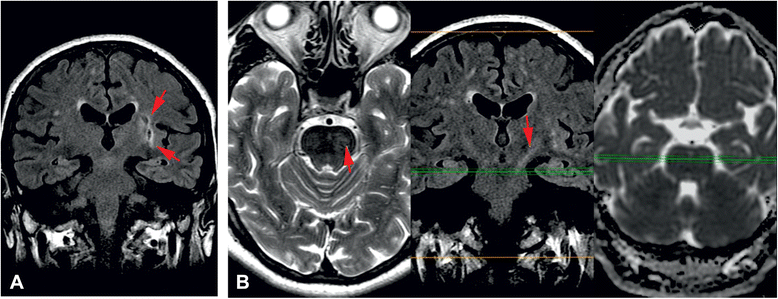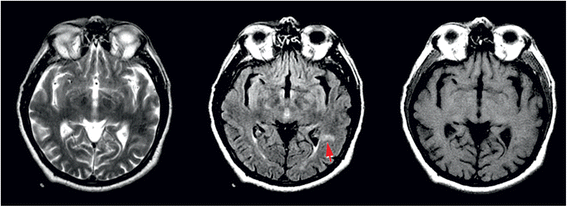Pathological laughter as prodromal manifestation of transient ischemic attacks--case report and brief review
- PMID: 26459199
- PMCID: PMC4603769
- DOI: 10.1186/s12883-015-0457-3
Pathological laughter as prodromal manifestation of transient ischemic attacks--case report and brief review
Abstract
Background: Based on a case report, the authors reviewed the data about involuntary emotional expression disorder (IEED). IEED includes the syndromes of pathological laughing and crying (PLC) and emotional lability (EL). PLC is a rare disorder of emotional expression characterized by relatively uncontrollable episodes of laughter and crying or both that do not have an apparent motivating stimulus.
Case presentation: Authors report the case of a 59-year-old man who presented with recurrent episodes of PLC of approximately 2 min duration, consisting of accelerated breathing, emission of guttural, snoring sounds, frowning of the eyebrows, followed by laughter accompanied by motor restlessness of all four limbs. PLC episodes preceded left carotid transient ischemic attacks (TIA's) manifested by reversible aphasia and right hemiparesis. Electroencephalography performed during PLC episodes revealed no spike-wave activity. Brain magnetic resonance imaging showed lacunar infarcts in the left lenticulo-capsulo-thalamic area and multiple round lesions in the cortical-subcortical and in the deep white matter of frontal-parietal-occipital lobes bilaterally, with T2 hyperintensity, T1 isointensity and no diffusion changes. The episodes were interpreted as transient ischemic attacks although gelastic seizures could not be excluded. The etiological investigations revealed unstable plaques on the left carotid artery bulb and the aortic arch and a degenerative mitral valve stenosis. The patient was treated first with antiplatelet therapy and antiepileptic drugs but PLC stopped only after anticoagulation was started. During follow-up the patient continued to have left carotid and vertebrobasilar TIA's being on oral anticoagulation. The patient became asymptomatic only after mitral valve replacement was performed.
Conclusions: This case illustrates the difficulty distinguishing between gelastic epilepsy and TIA's in cases of PLC episodes and discuss the neuroanatomic bases and pathophysiology of this rare condition.
Figures




Similar articles
-
Toward a more precise, clinically--informed pathophysiology of pathological laughing and crying.Neurosci Biobehav Rev. 2013 Sep;37(8):1893-916. doi: 10.1016/j.neubiorev.2013.03.002. Epub 2013 Mar 18. Neurosci Biobehav Rev. 2013. PMID: 23518269 Review.
-
Disabling cerebral transient ischemic attacks.J Neurosurg. 1991 Dec;75(6):891-901. doi: 10.3171/jns.1991.75.6.0891. J Neurosurg. 1991. PMID: 1834811
-
[Transient ischemic attacks before and after occlusion of the internal carotid artery].Rev Neurol (Paris). 1983;139(11):625-33. Rev Neurol (Paris). 1983. PMID: 6677975 French.
-
Pathological laughter and crying: a link to the cerebellum.Brain. 2001 Sep;124(Pt 9):1708-19. doi: 10.1093/brain/124.9.1708. Brain. 2001. PMID: 11522574
-
[Neurology of laughter and humour: pathological laughing and crying].Rev Neurol. 2011 Oct 1;53(7):415-21. Rev Neurol. 2011. PMID: 21948012 Review. Spanish.
Cited by
-
Pathological Laughter Prodromal to a Stroke of the Head of the Left Caudate Nucleus.Case Rep Neurol. 2022 Jan 13;14(1):1-4. doi: 10.1159/000521304. eCollection 2022 Jan-Apr. Case Rep Neurol. 2022. PMID: 35221969 Free PMC article.
-
Pathological Laughter in a Female with Multiple Episodes of Stroke and Subdural Hematoma.Indian J Psychol Med. 2017 Jul-Aug;39(4):503-505. doi: 10.4103/0253-7176.211747. Indian J Psychol Med. 2017. PMID: 28852248 Free PMC article.
-
Pathological Laughter: The First Manifestation of Intracerebral Haemorrhage Linked to Phenylephrine Overuse.Cureus. 2024 Jun 29;16(6):e63461. doi: 10.7759/cureus.63461. eCollection 2024 Jun. Cureus. 2024. PMID: 39077269 Free PMC article.
-
Lack of a Sense of Threat and Higher Emotional Lability in Patients With Chronic Microvascular Ischemia as Measured by Non-linear EEG Parameters.Front Neurol. 2020 Mar 12;11:122. doi: 10.3389/fneur.2020.00122. eCollection 2020. Front Neurol. 2020. PMID: 32226407 Free PMC article.
-
Pathological laughter as onset symptom in atypical parkinsonisms.J Neurol. 2017 Jan;264(1):182-184. doi: 10.1007/s00415-016-8351-5. Epub 2016 Nov 24. J Neurol. 2017. PMID: 27885486 No abstract available.
References
-
- Poeck K. Pathophysiology of emotional disorders associated with brain damage. In: Vinken PJ, Bruyn GW, editors. Handbook of clinical neurology, vol. 3. Amsterdam: Elsevier; 1969. p. 343–67.
-
- Poeck K. Pathological laughter and crying. In: Frederik S, editor. Handbook of clinical neurology, Volume 1. Amsterdam: Elsevier; 1985. pp. 219–225.
Publication types
MeSH terms
LinkOut - more resources
Full Text Sources
Other Literature Sources
Medical

